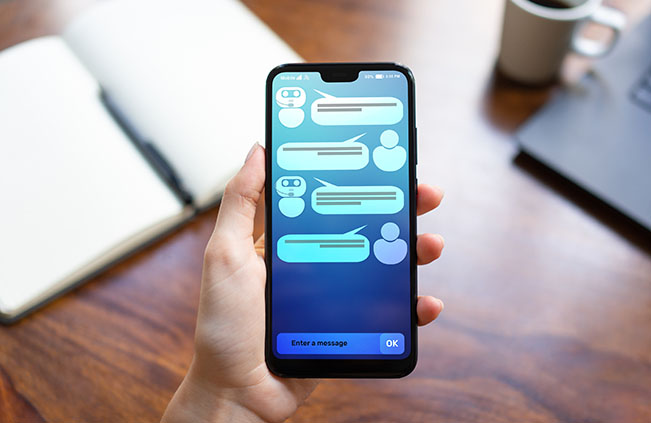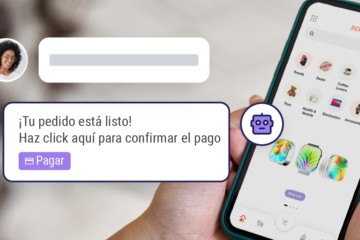Building a chatbot is becoming more and more affordable for companies. There are even applications that allow you to create conversational interfaces without writing code. However, to successfully implement a chatbot and enhance the customer service strategy (especially in contact centers that handle numerous campaigns and a high volume of interactions), it is important to consider several factors.
It is not only about creating the chatbot itself, but also about its integration with the ecosystem of media, channels and data used by the company. Only in this way, self-service really brings value to users and to the operation as a whole. In this article we share with you the main keys to successfully implement a chatbot, based on our experience developing omnichannel bots for various types of contact centers.
1) Define your objectives to find the perfect type of chatbot
There are many types of bots, based on technologies with different levels of complexity. In fact, in this article we talk about “chatbots” because the most frequent use of bots is via chat or instant messaging. But there are also voice bots (called voicebots or voice portals), for which these recommendations apply.
In addition to the medium used, bots can be classified according to the application (or not) of artificial intelligence. Cognitive or intelligent chatbots rely on NLU (Natural Language Understanding) systems to process and interpret natural language; while “Dumb Bots” or “RTI chatbots” operate on the basis of a pre-configured system of responses, without employing artificial intelligence.
How do you know which type of chabtot is right for your business? Being clear about your objective.
If the purpose of your bot is to offer a pre-service system before contacting an agent, or to answer frequently asked questions such as opening hours or address, you probably don’t need artificial intelligence.
If you need to solve more complex operations, with a wide variety of possible queries or requirements (such as booking a hotel, for example), an RTI bot will not be enough. In those cases you will need an intelligent bot, capable of covering multiple service scenarios.
2) Form an interdisciplinary team
A common mistake in the implementation of bots is to think that they are only the responsibility of IT technicians. A fundamental key to make the chatbot a success is to involve experts in different areas and generate a multidisciplinary work. In addition to engineers, this includes linguists, artificial intelligence experts, customer success specialists, marketing analysts and designers. From the management positions in charge of defining the objectives, to the service representatives who have vast experience in dealing with customers, all contribute their expertise to make the chatbot functional and offer an excellent customer experience.

3) Create customer-centric conversational flows.
Behind every interaction with a chatbot, previously configured conversational flows unfold. Work with your team in the diagramming of these workflows, detecting possible “loose ends”, unexpected customer responses and ways to channel the conversation.
Knowing your customer well is vital to design workflows and apply a conversational logic that really works. You must anticipate their needs, concerns and expectations, so that the bot can give them satisfactory answers. This includes the bot’s personality and communication style, aligned not only to the values and tone of your brand but also to the socio-demographic profile of your customers.
4) Integrate your chatbot with other business systems and applications.
In many cases, for the bot to be able to provide an efficient service, it will need to resolve certain operations by itself, from coordinating an e-commerce order to approving a loan. For this you will need a transactional chatbot, which in addition to conversing naturally, integrates with your company’s information systems (ERPs, CRM or other business applications) to solve certain cases.
In addition, this integration of the bot with management systems and applications allows you to provide a personalized conversational experience by accessing personal data or customer history. Or conversely, it also allows you to capture customer data that is then processed in the subsequent stages of marketing, sales or customer service.
5) Train your chatbot
Chatbots that employ artificial intelligence have as a central feature their “active learning” capability. This means that they can not only interpret the natural language of users to extract the intentions of each sentence. They also continuously learn from interactions to interpret and provide increasingly accurate responses.
This is why the bot training stage is so important, prior to the bot going live. This is done in the “bot training” portals, where from a knowledge base the bot is “taught” the expressions of each type of intention, for example, or in which cases it should ask for certain information to be able to give a more accurate answer. This training is more intense in the stage prior to the launch of the chatbot. But it is something that never ends, and must be constantly performed as maintenance to ensure its proper functioning and also to incorporate new products, services or business processes.
6) Define the channels where the chatbot will be present
We can generate the most sophisticated and friendly chatbot, capable of solving millions of queries. But if we don’t let our customers know that a chatbot is available, nor integrate it in the right channel, the self-service strategy will be a failure.
It is important to define in which environments your chatbot will interact: whether it will be on your ecommerce page, on WhatsApp, on social networks, on a specific landing page or app, on the home page of your website, or if you require a telephone voicebot. To know which is the best usage scenario, analyze your operation’s data and define the most friendly channels for your customers. If most of your customers already use WhatsApp to communicate with your company, it may be more convenient to implement a bot in this channel, instead of creating a specific page to implement it.

7) Test, measure, optimize
Before launching the chatbot, test it. First internally and then with a segment of your audience. Check for possible flaws in the conversational flows. After its official launch, it is important to keep collecting data (engagement rates, abandonment, resolution, etc.) so that the bot’s improvement is continuous.
Pay attention to all the details, from typos that the chatbot is misinterpreting, to new capabilities that you could incorporate according to customer concerns. A good idea is to include a satisfaction survey at the end of each interaction to analyze compliance with service levels.
8) Leave the way open to interact with an agent.
A recommendation that we always highlight when we talk about a successful implementation of chatbots, is to leave the possibility of a human agent intervening in case the customer requests it, or if the bot detects that it is not able to solve the customer’s question or request.
When the chatbot is integrated to the omnichannel customer service platform -as is the case of inConcert- the user experience remains optimal because the agent who takes the interaction receives the previous history of the chat, as well as other customer data that serve to move forward with the most efficient resolution.




